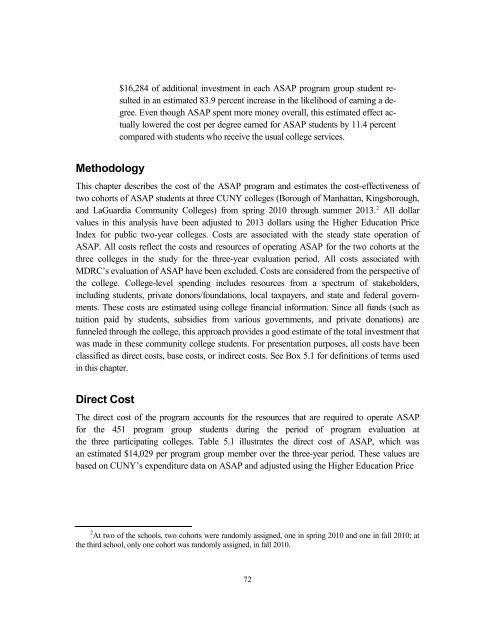1dOprzL
1dOprzL
1dOprzL
You also want an ePaper? Increase the reach of your titles
YUMPU automatically turns print PDFs into web optimized ePapers that Google loves.
$16,284 of additional investment in each ASAP program group student resultedin an estimated 83.9 percent increase in the likelihood of earning a degree.Even though ASAP spent more money overall, this estimated effect actuallylowered the cost per degree earned for ASAP students by 11.4 percentcompared with students who receive the usual college services.MethodologyThis chapter describes the cost of the ASAP program and estimates the cost-effectiveness oftwo cohorts of ASAP students at three CUNY colleges (Borough of Manhattan, Kingsborough,and LaGuardia Community Colleges) from spring 2010 through summer 2013. 2 All dollarvalues in this analysis have been adjusted to 2013 dollars using the Higher Education PriceIndex for public two-year colleges. Costs are associated with the steady state operation ofASAP. All costs reflect the costs and resources of operating ASAP for the two cohorts at thethree colleges in the study for the three-year evaluation period. All costs associated withMDRC’s evaluation of ASAP have been excluded. Costs are considered from the perspective ofthe college. College-level spending includes resources from a spectrum of stakeholders,including students, private donors/foundations, local taxpayers, and state and federal governments.These costs are estimated using college financial information. Since all funds (such astuition paid by students, subsidies from various governments, and private donations) arefunneled through the college, this approach provides a good estimate of the total investment thatwas made in these community college students. For presentation purposes, all costs have beenclassified as direct costs, base costs, or indirect costs. See Box 5.1 for definitions of terms usedin this chapter.Direct CostThe direct cost of the program accounts for the resources that are required to operate ASAPfor the 451 program group students during the period of program evaluation atthe three participating colleges. Table 5.1 illustrates the direct cost of ASAP, which wasan estimated $14,029 per program group member over the three-year period. These values arebased on CUNY’s expenditure data on ASAP and adjusted using the Higher Education Price2 At two of the schools, two cohorts were randomly assigned, one in spring 2010 and one in fall 2010; atthe third school, only one cohort was randomly assigned, in fall 2010.72


